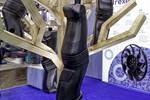New Micro-Foam Solutions for Bottles
Trexel is offering hardware to enable use of microcellular foams in blow molded packaging with complex shapes, handles and PCR content, while retaining impact strength.

Bottle with 50% PCR in core layer foamed with MuCell process saves weight while meeting impact-strength and topload requirements. Trexel’s MuCell B-Series nitrogen delivery unit, developed for blow molding, is the only extra equipment needed. (Photo: Trexel, Inc.)
As reported recently, Trexel, Inc. has broadened the availability of its royalty-free MuCell microcellular foam technology for blow molding applications beyond just automotive to the entire extrusion blow molding market. Trexel has followed up on that July announcement with information on its packaging solutions for cosmetics, detergents, and other household products. The company says MuCell technology can offer up to 20% lightweighting and ability to use post-consumer recycled content in larger containers and those with squarer shapes and/or handles, while still meeting impact-strength requirements. According to Trexel, lightweighting by up to 20% at similar wall thickness preserves adequate impact strength.
Trexel’s physical foaming process reportedly improves on chemical foaming agents and previous physical foaming methods by offering smaller and more uniform foam cells, enabling greater density reduction and improved mechanical properties. Also, the MuCell process does not add waxes or stearates that can cause mold buildup and other problems. Use of up 80% PCR in the core layer of a coextrusion is said to be possible, and density reduction helps offset the cost of PCR.
To implement MuCell technology in blow molding, all that’s required is addition of an industry-standard threaded hole in the barrel for injection of pressurized nitrogen with Trexel’s B-series delivery system, which was developed specifically for blow molding. Blow molders can use their existing screws, due to the low level of blowing agent required. The threaded hole is added toward the end of the barrel, in a zone where the resin is already melted while leaving enough residence time for dissolving the blowing agent over the last few diameters of metering or mixing element. Trexel also recommends addition of a proprietary low-cost ingredient to ensure optimum foaming.
The MuCell B-series has automatic dose correction to ensure part-to-part consistency and responds to even small variations in cycle time, enabled by a signal from the molding machine. The system “learns” the behavior of the machine and makes required corrections in a matter of shots. This is important for maintaining consistent parison tail length, because foam increases the parison volume. The B-Series also comes with dosing modes for continuous and discontinuous screw rotation to accommodate machines with continuous extrusion, reciprocating screw or accumulator heads.
At press time, Borealis announced that it will exhibit at K 2022 a three-layer bottle made of its renewably sourced PP with MuCell foam in its center layer.
Related Content
-
US Merchants Makes its Mark in Injection Molding
In less than a decade in injection molding, US Merchants has acquired hundreds of machines spread across facilities in California, Texas, Virginia and Arizona, with even more growth coming.
-
Solve Four Common Problems in PET Stretch-Blow Molding
Here’s a quick guide to fixing four nettlesome problems in processing PET bottles.
-
In Sustainable Packaging, the Word is ‘Monomaterial’
In both flexible and rigid packaging, the trend is to replace multimaterial laminates, coextrusions and “composites” with single-material structures, usually based on PE or PP. Nonpackaging applications are following suit.
















